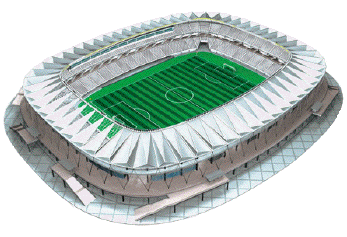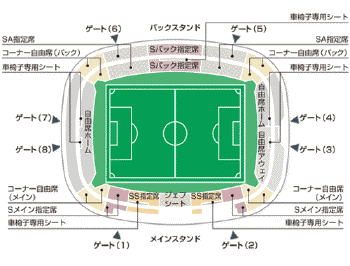Chiba Fukuda Arena
aka: "Fukuari Stadium"
Soga City, Chiba Prefecture
"Fukuari Stadium" is one of the newer stadiums in the J.League. It was built several years after the construction boom that preceded the 2002 World Cup, and though it may not be quite as large or as well-appointed as the stadia that hosted Korea/Japan2002, it is a dramatic upgrade from the cramped and cold surroundings of Ichihara Seaside Stadium, where fans of JEF United languished throughout the league's first decade. Some would argue that it is one of Japan's top football-only facilities, with easy and convenient access, and ample seating capacity.
Perhaps this view was justified back in the early 00s, when it hosted two Nabisco Cup title runs (2005 and 2006). But conditions change, and nowadays the stadium's demerits get more attention than its architectural beauty. Start with the stadium's nickname -- "Fukuari" did derive from a corporate branding effort, but if the oblective of corporate branding is to have your name mentioned constantly, this was a botch job.
The official name of the stadium is the "Fukuda Electric Arena." but modern Japanese - by which I mean, the language spoken by milennials and most of Gen X Y and Z - abhors proper nouns with more than four or five syllables. Thus "Ajinomoto Stadium" has become "AjiSta"and Saitama Stadium 2002 is simply "SaiSta". For some reason, though, most fans began referring to Fukuda Electric Arena, their new home, as "Fukuari Stadium," taking the "Fuku" from FUKUda and and the "Aree" from AREna. Nobody really knows why they felt it necessary to add the redundant word "Stadium" (Not just redundant, but confusing -- which is it: an arena? or a stadium?) , but the name stuck.
As noted already, the first few seasons at Fukuari were crowned with success. At the time it was built, JEF United was at the peak of competitiveness, under Ivica Osim. JEF finished in the top five, in four if the first five years of the century, and won the Nabisco Cup in 2005 and 2006. Fukuari frequently sold out. But the happy times would not last long. Osim was tapped to lead the Japan National Team in July 2006, and over the next four seasons all of the top JEF players moved to Europe, in order to bolster their NT prospects, Management failed to bring in enough new talent, and the team spent the next four seasons rapidly descending the ladder, dropping into the J2 in 2009 and slipping steadily further into mediocrity.
|
Which brings us to the demerits of Fukuari Stadium. As is the case with Saitama Stadium, despite being football-only, the stands "feel" rather far from the pitch. When full, this impression is offset by the sheer noise of a raucous home crowd. Unfortunately, Fukuari's 18,500-seat capacity is far too large for the current JEF United Chiba. Since moving to Fukuari, average attendances have plunged from 14-15,000 (in 2006-09) to a mere 9,000. And yet, the atmosphere is still a dramatic improvement from conditions at Ichihara Seaside. Unlike Nagoya Grampus, who still play a large number of contests at Mizuho Stadium even now that the magnificent Toyota Stadium is available, JEF United no longer uses Ichihara Seaside for anything but youth and Nadeshiko league (JRF United Ladies) matches. |
 |
Fukuda Electric Arena
| Location: Soga City, Chiba Prefecture | Capacity: 18,500 | |
| Home Team(s): JEF United Ichihara | Completed: 2005 |
Stadium Access |
 Click to enlarge |
 |
Ticket PricesGeneral admission: |
Pictures of Fukuari Stadium

